belt Lexus GS350 2007 Using the interior lights / LEXUS 2007 GS430/350 (OM30A04U) User Guide
[x] Cancel search | Manufacturer: LEXUS, Model Year: 2007, Model line: GS350, Model: Lexus GS350 2007Pages: 562
Page 56 of 562
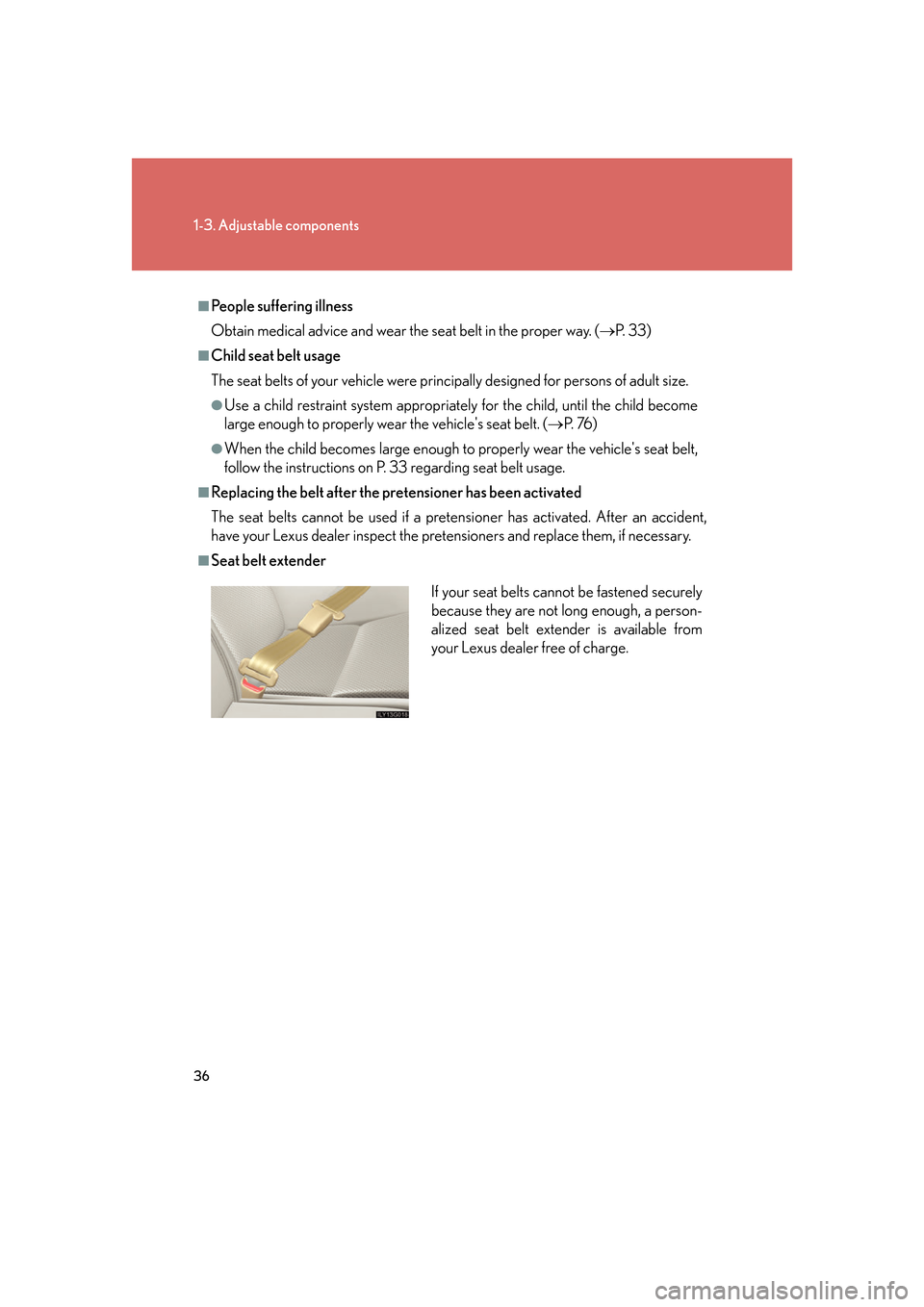
36
1-3. Adjustable components
■People suffering illness
Obtain medical advice and wear the seat belt in the proper way. (P. 3 3 )
■Child seat belt usage
The seat belts of your vehi cle were principally designed for persons of adult size.
●Use a child restraint system appropriately for the child, until the child become
large enough to properly wear the vehicle's seat belt. ( P. 76 )
●When the child becomes large enough to properly wear the vehicle's seat belt,
follow the instructions on P. 33 regarding seat belt usage.
■Replacing the belt after the pretensioner has been activated
The seat belts cannot be used if a preten sioner has activated. After an accident,
have your Lexus dealer inspect the pretensioners and replace them, if necessary.
■Seat belt extender
If your seat belts cannot be fastened securely
because they are not long enough, a person-
alized seat belt extender is available from
your Lexus dealer free of charge.
Page 57 of 562
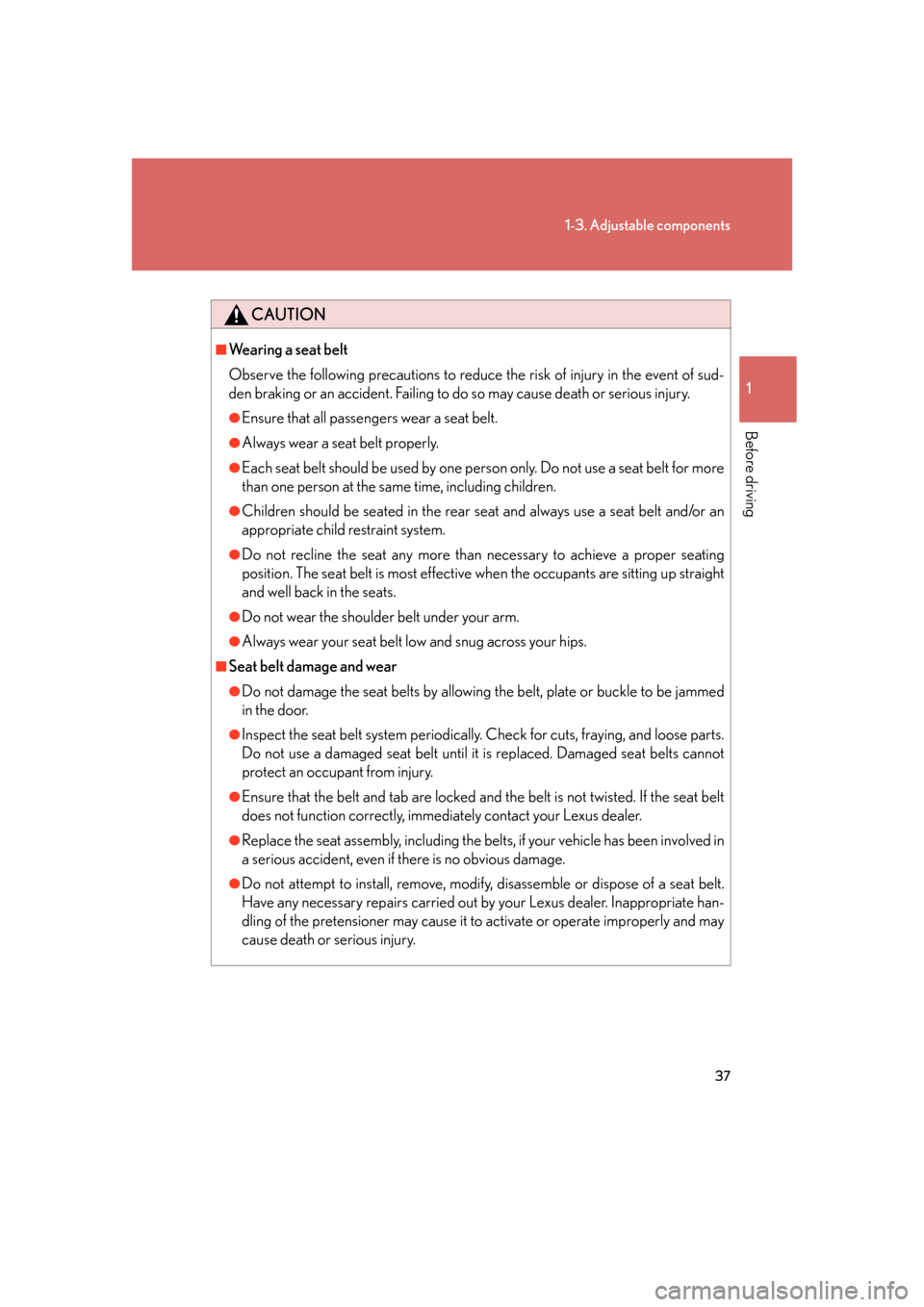
37
1-3. Adjustable components
1
Before driving
CAUTION
■Wearing a seat belt
Observe the following precautions to reduce the risk of injury in the event of sud-
den braking or an accident. Failing to do so may cause death or serious injury.
●Ensure that all passengers wear a seat belt.
●Always wear a seat belt properly.
●Each seat belt should be used by one person only. Do not use a seat belt for more
than one person at the same time, including children.
●Children should be seated in the rear seat and always use a seat belt and/or an
appropriate child restraint system.
●Do not recline the seat any more than necessary to achieve a proper seating
position. The seat belt is most effective when the occupants are sitting up straight
and well back in the seats.
●Do not wear the shoulder belt under your arm.
●Always wear your seat belt low and snug across your hips.
■Seat belt damage and wear
●Do not damage the seat belts by allowing the belt, plate or buckle to be jammed
in the door.
●Inspect the seat belt system periodically. Check for cuts, fraying, and loose parts.
Do not use a damaged seat belt until it is replaced. Damaged seat belts cannot
protect an occupant from injury.
●Ensure that the belt and tab are locked and the belt is not twisted. If the seat belt
does not function correctly, immediately contact your Lexus dealer.
●Replace the seat assembly, including the belt s, if your vehicle has been involved in
a serious accident, even if there is no obvious damage.
●Do not attempt to install, remove, modify , disassemble or dispose of a seat belt.
Have any necessary repairs carried out by your Lexus dealer. Inappropriate han-
dling of the pretensioner may cause it to activate or operate improperly and may
cause death or serious injury.
Page 58 of 562
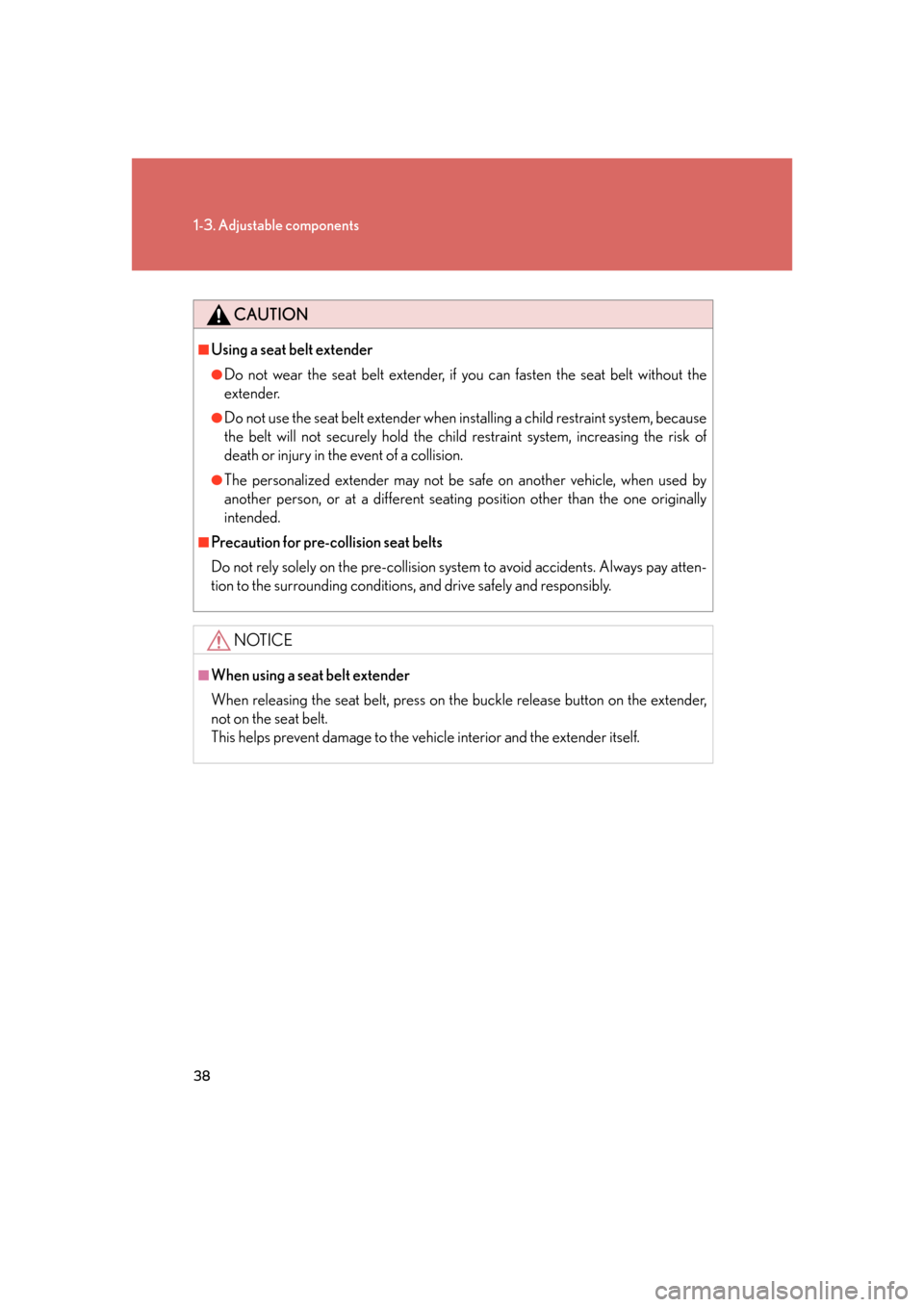
38
1-3. Adjustable components
CAUTION
■Using a seat belt extender
●Do not wear the seat belt extender, if you can fasten the seat belt without the
extender.
●Do not use the seat belt extender when in stalling a child restraint system, because
the belt will not securely hold the child restraint system, increasing the risk of
death or injury in the event of a collision.
●The personalized extender may not be safe on another vehicle, when used by
another person, or at a different seating position other than the one originally
intended.
■Precaution for pre-collision seat belts
Do not rely solely on the pre-collision system to avoid accidents. Always pay atten-
tion to the surrounding conditions, and drive safely and responsibly.
NOTICE
■When using a seat belt extender
When releasing the seat belt, press on the buckle release button on the extender,
not on the seat belt.
This helps prevent damage to the vehi cle interior and the extender itself.
Page 62 of 562
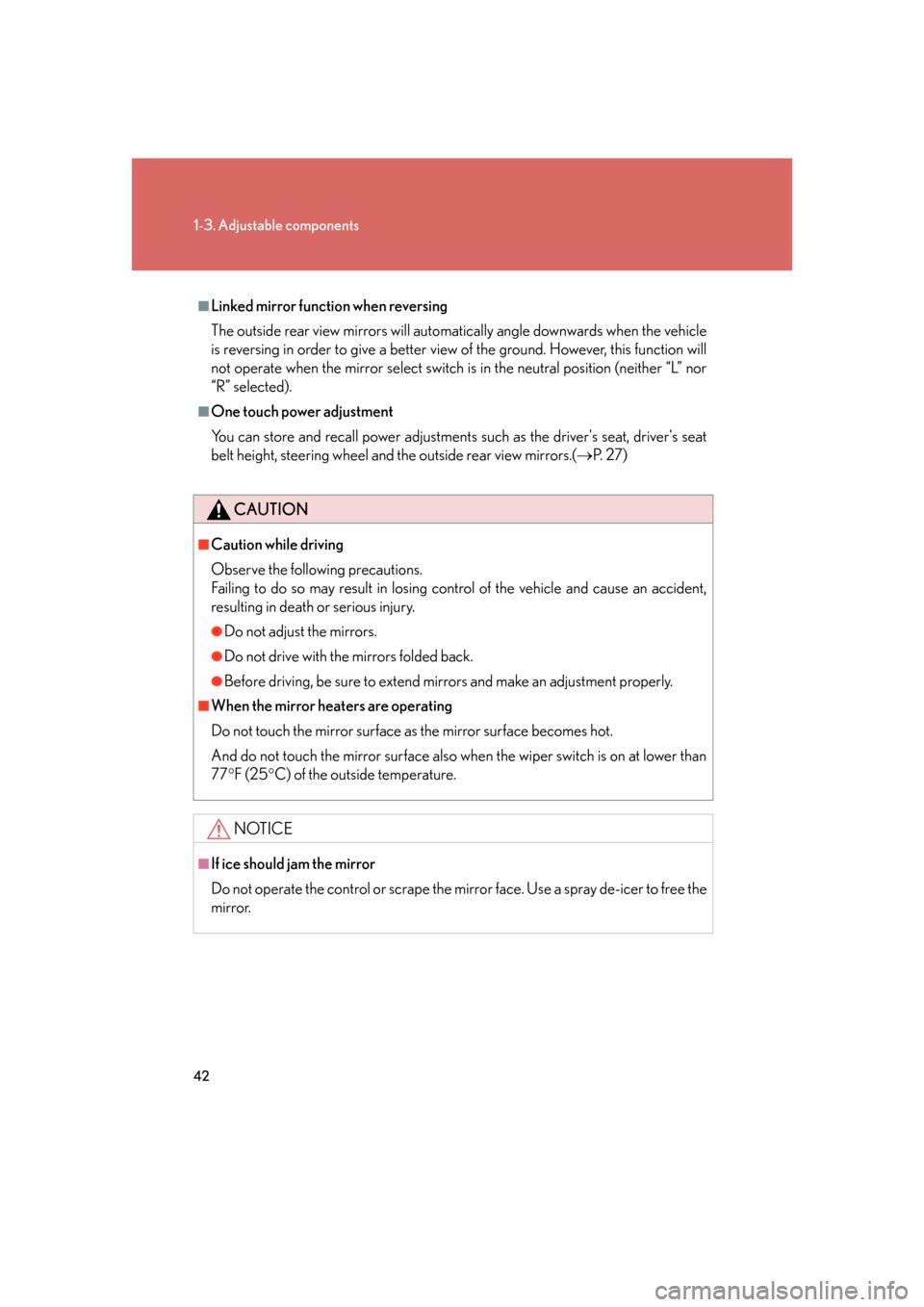
42
1-3. Adjustable components
■Linked mirror function when reversing
The outside rear view mirrors will automatically angle downwards when the vehicle
is reversing in order to give a better view of the ground. However, this function will
not operate when the mirror select switch is in the neutral position (neither “L” nor
“R” selected).
■One touch power adjustment
You can store and recall power adjustments su ch as the driver's seat, driver's seat
belt height, steering wheel and the outside rear view mirrors.( P. 2 7 )
CAUTION
■Caution while driving
Observe the following precautions.
Failing to do so may result in losing control of the vehicle and cause an accident,
resulting in death or serious injury.
●Do not adjust the mirrors.
●Do not drive with the mirrors folded back.
●Before driving, be sure to extend mirrors and make an adjustment properly.
■When the mirror heaters are operating
Do not touch the mirror surface as the mirror surface becomes hot.
And do not touch the mirror surface also wh en the wiper switch is on at lower than
77 F (25 C) of the outside temperature.
NOTICE
■If ice should jam the mirror
Do not operate the control or scrape the mi rror face. Use a spray de-icer to free the
mirror.
Page 77 of 562
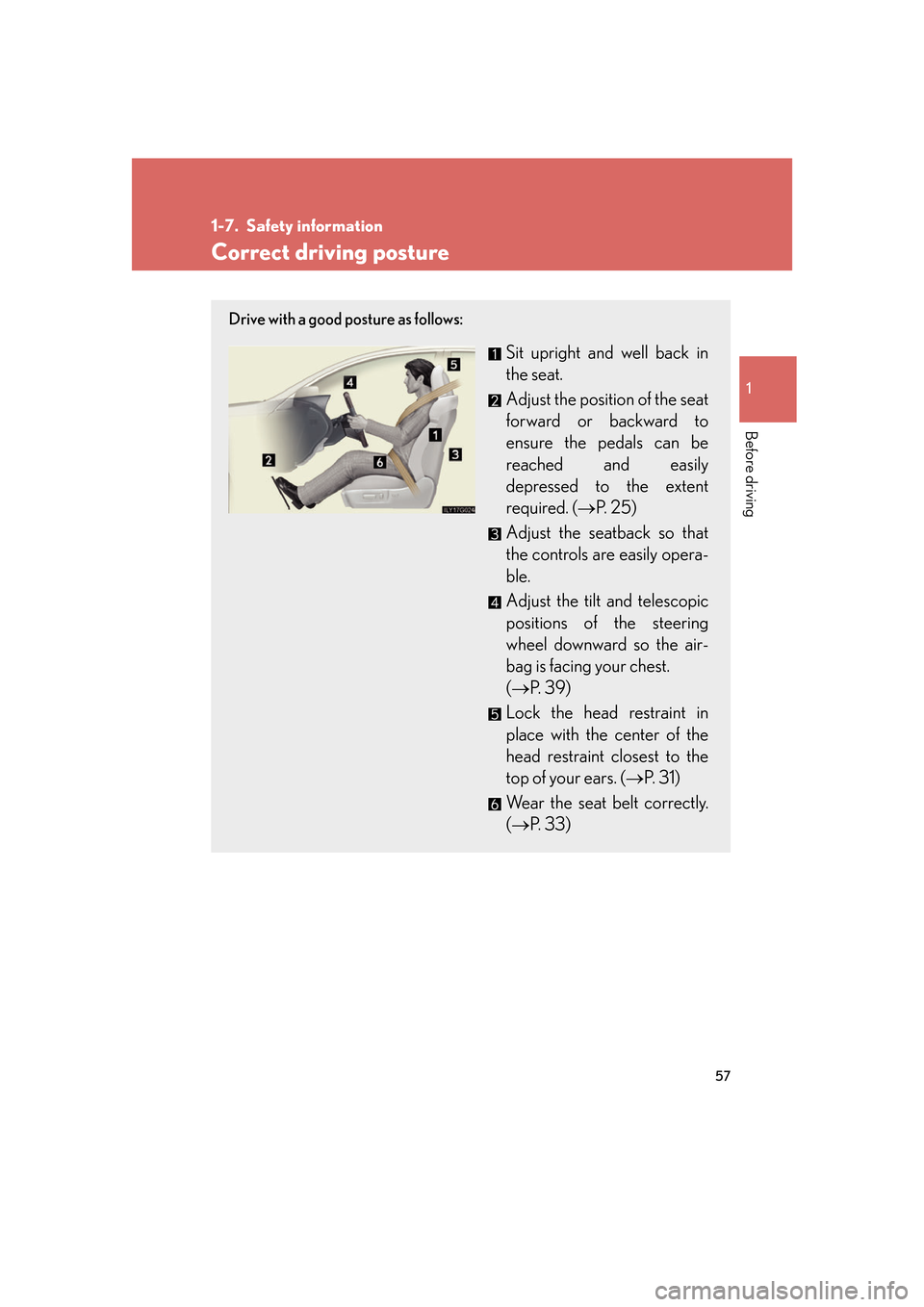
57
1
Before driving
1-7. Safety information
Correct driving posture
Drive with a good posture as follows:
Sit upright and well back in
the seat.
Adjust the position of the seat
forward or backward to
ensur
e the pedals can be
reached and easily
depressed to the extent
required. ( P. 2 5 )
Adjust the seatback so that
the controls are easily opera -
ble.
Adjust the tilt and telescopic
positions of the steering
wheel do
wnward so the air -
bag is facing your chest.
( P. 39 )
Lock the head restraint in
place with the center of the
head r
estraint closest to the
top of your ears. ( P. 31 )
Wear the seat belt correctly.
( P. 3 3 )
Page 78 of 562
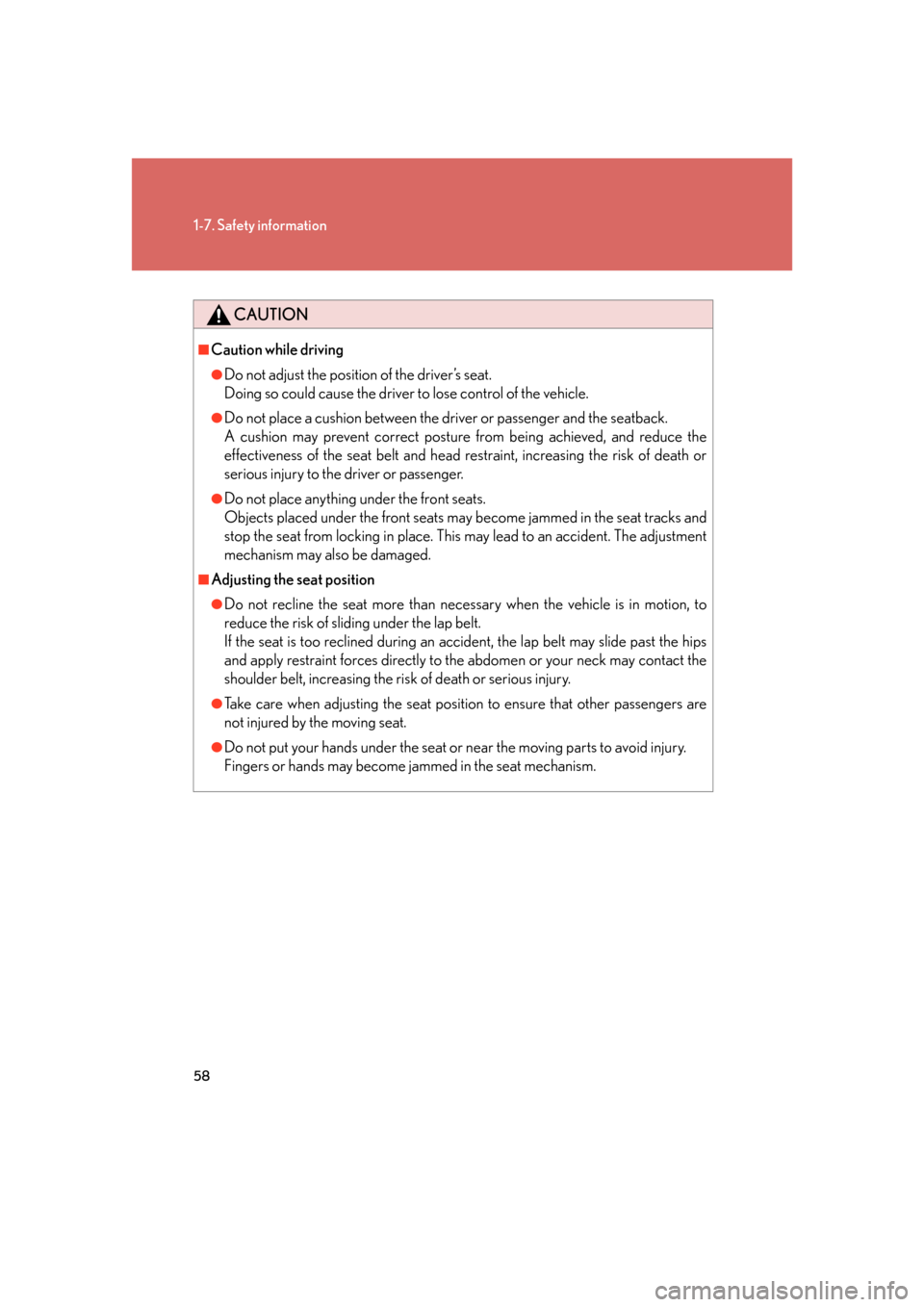
58
1-7. Safety information
CAUTION
■Caution while driving
●Do not adjust the position of the driver’s seat.
Doing so could cause the driver to lose control of the vehicle.
●Do not place a cushion between the driver or passenger and the seatback.
A cushion may prevent correct posture from being achieved, and reduce the
effectiveness of the seat belt and head re straint, increasing the risk of death or
serious injury to the driver or passenger.
●Do not place anything under the front seats.
Objects placed under the front seats may become jammed in the seat tracks and
stop the seat from locking in place. This may lead to an accident. The adjustment
mechanism may also be damaged.
■Adjusting the seat position
●Do not recline the seat more than necessary when the vehicle is in motion, to
reduce the risk of slid ing under the lap belt.
If the seat is too reclined during an accident, the lap belt may slide past the hips
and apply restraint forces directly to th e abdomen or your neck may contact the
shoulder belt, increasing the ri sk of death or serious injury.
●Take care when adjusting the seat position to ensure that other passengers are
not injured by the moving seat.
●Do not put your hands under the seat or near the moving parts to avoid injury.
Fingers or hands may become jammed in the seat mechanism.
Page 79 of 562
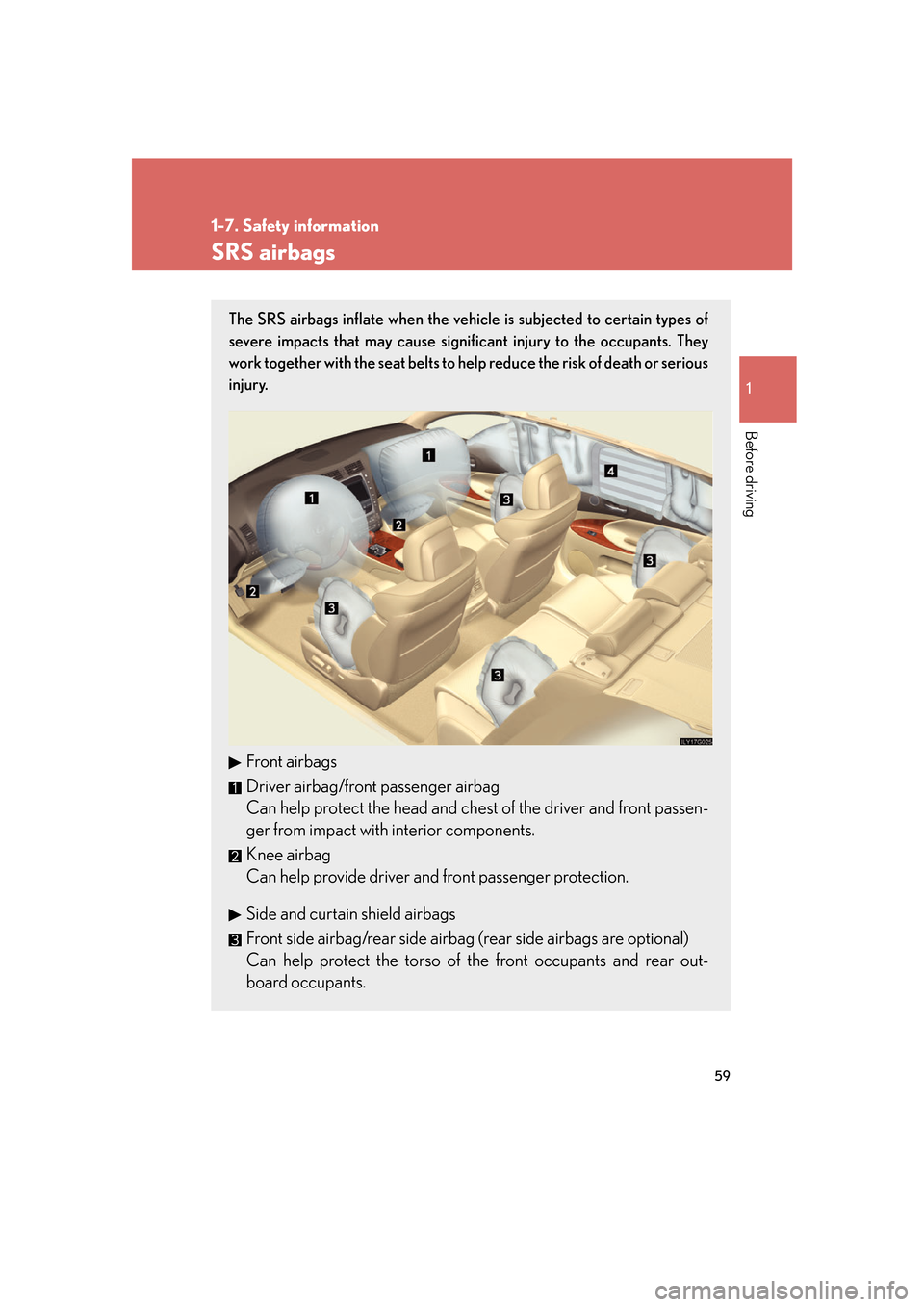
59
1
1-7. Safety information
Before driving
SRS airbags
The SRS airbags inflate when the vehicle is subjected to certain types of
severe impacts that may cause signific ant injury to the occupants. They
work together with the seat belts to he lp reduce the risk of death or serious
injury.
Front airbags
Driver airbag/front passenger airbag
Can help protect the head and ch est of the driv
er and front passen-
ger from impact with interior components.
Knee airbag
Can help provide driver and front passenger protection.
Side and curtain shield airbags
Front side airbag/rear side airbag (r
ear side airbags are optional)
Can help protect the torso of th e f
ront occupants and rear out-
board occupants.
Page 80 of 562
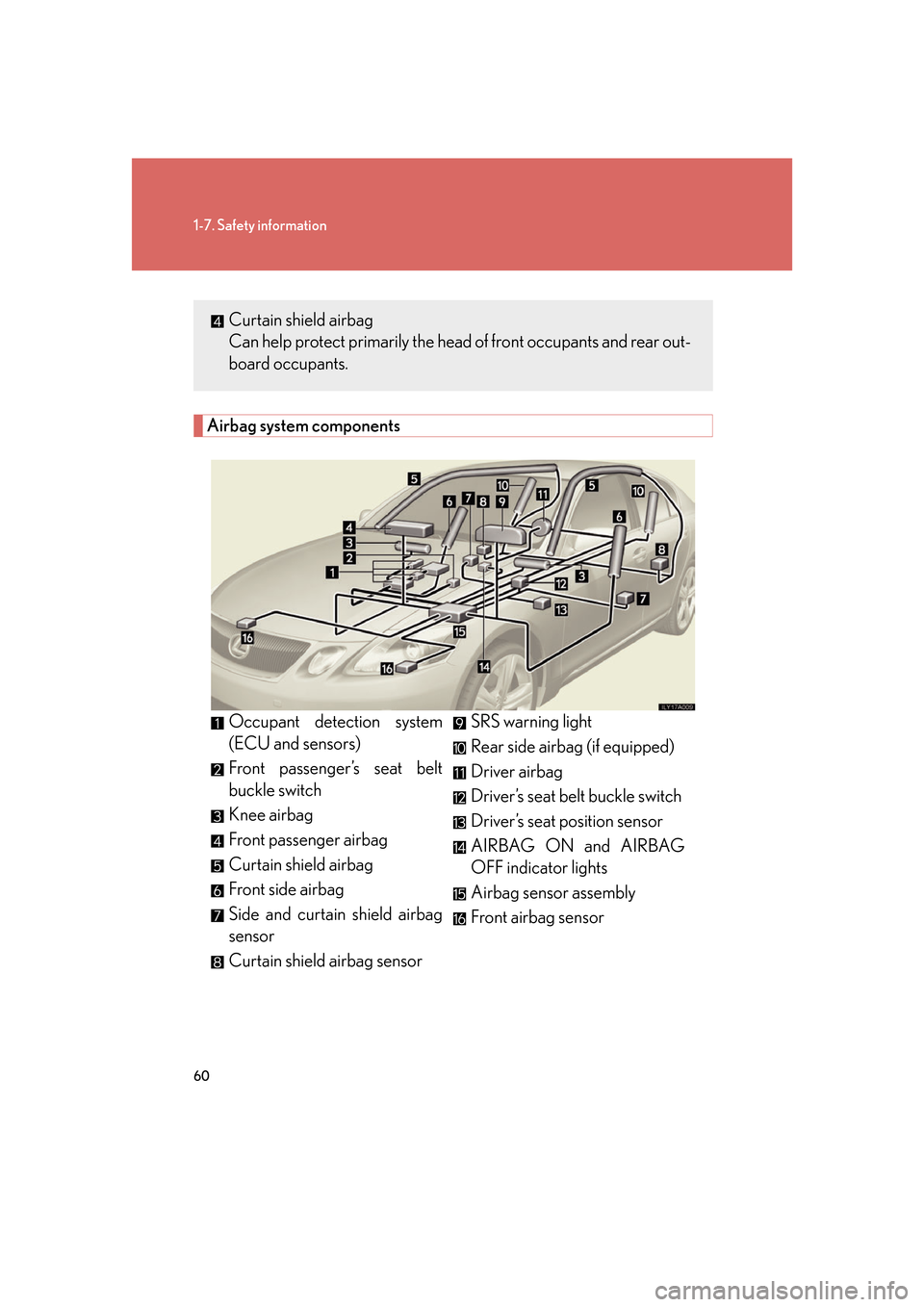
60
1-7. Safety information
Airbag system components
Occupant detection system
(ECU and sensors)
Front passenger’s seat belt
buckle switch
Knee airbag
Front passenger airbag
Curtain shield airbag
Front side airbag
Side and curtain shield airbag
sensor
Curtain shield airbag sensorSRS warning light
Rear side airbag (if equipped)
Driver airbag
Driver’s seat belt buckle switch
Driver’s seat position sensor
AIRBAG ON and AIRBAG
OFF indicator lights
Airbag sensor assembly
Front airbag sensor
Curtain shield airbag
Can help protect primarily the head of fr
ont occupants and rear out-
board occupants.
Page 82 of 562
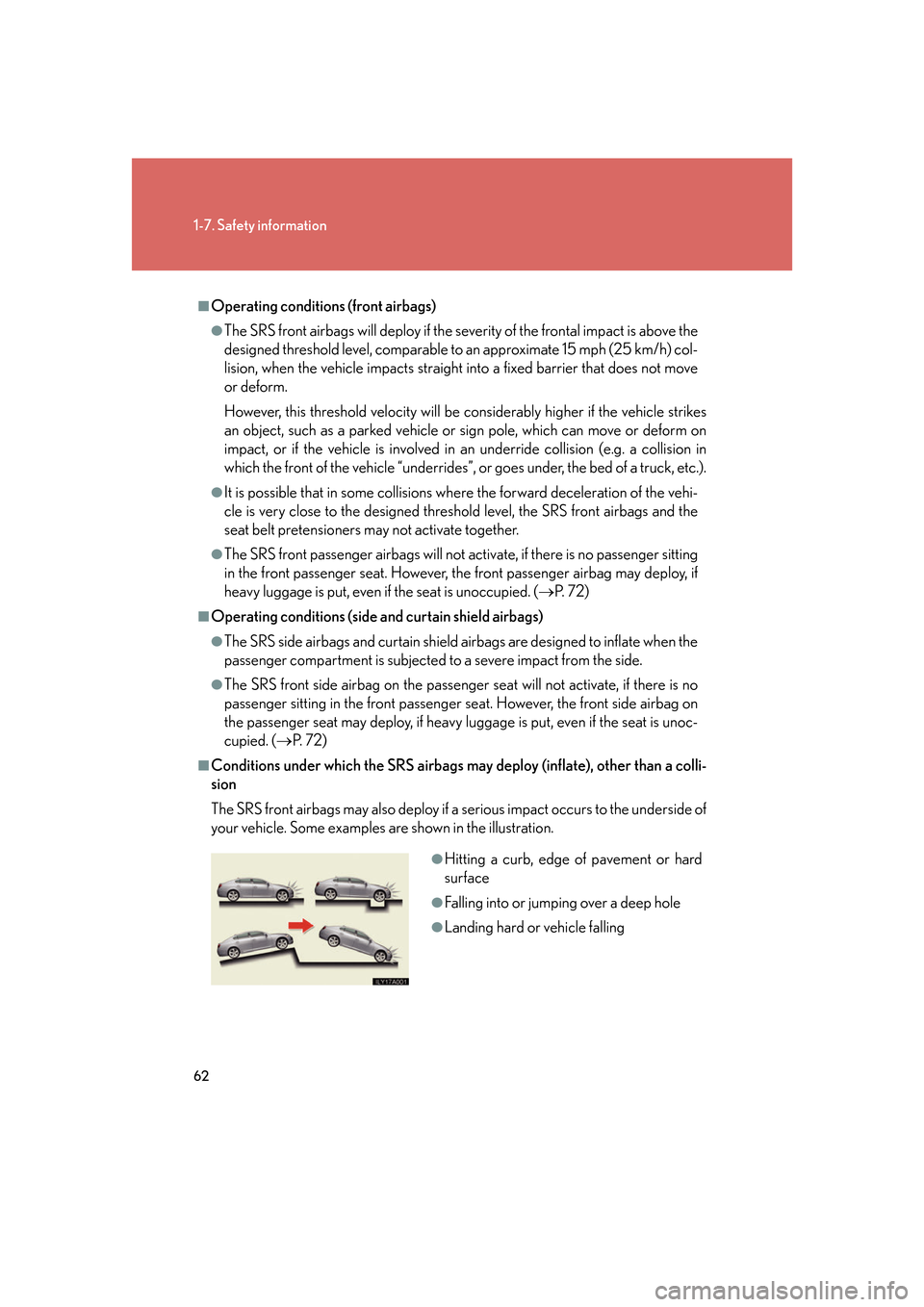
62
1-7. Safety information
■Operating conditions (front airbags)
●The SRS front airbags will deploy if the severity of the frontal impact is above the
designed threshold level, comparable to an approximate 15 mph (25 km/h) col-
lision, when the vehicle impacts straight into a fixed barrier that does not move
or deform.
However, this threshold velocity will be considerably higher if the vehicle strikes
an object, such as a parked vehicle or sign pole, which can move or deform on
impact, or if the vehicle is involved in an underride collision (e.g. a collision in
which the front of the vehicle “underrides”, or goes under, the bed of a truck, etc.).
●It is possible that in some collisions where the forward deceleration of the vehi-
cle is very close to the designed thresh old level, the SRS front airbags and the
seat belt pretensioners ma y not activate together.
●The SRS front passenger airbags will not activate, if there is no passenger sitting
in the front passenger seat. However, th e front passenger airbag may deploy, if
heavy luggage is put, even if the seat is unoccupied. ( P. 7 2 )
■Operating conditions (side and curtain shield airbags)
●The SRS side airbags and curtain shield ai rbags are designed to inflate when the
passenger compartment is subjected to a severe impact from the side.
●The SRS front side airbag on the passenger seat will not activate, if there is no
passenger sitting in the front passenger seat. However, the front side airbag on
the passenger seat may deploy, if heavy luggage is put, even if the seat is unoc-
cupied. ( P. 7 2 )
■Conditions under which the SRS airbags may deploy (inflate), other than a colli-
sion
The SRS front airbags may also deploy if a serious impact occurs to the underside of
your vehicle. Some examples are shown in the illustration.
●Hitting a curb, edge of pavement or hard
surface
●Falling into or jumping over a deep hole
●Landing hard or vehicle falling
Page 85 of 562
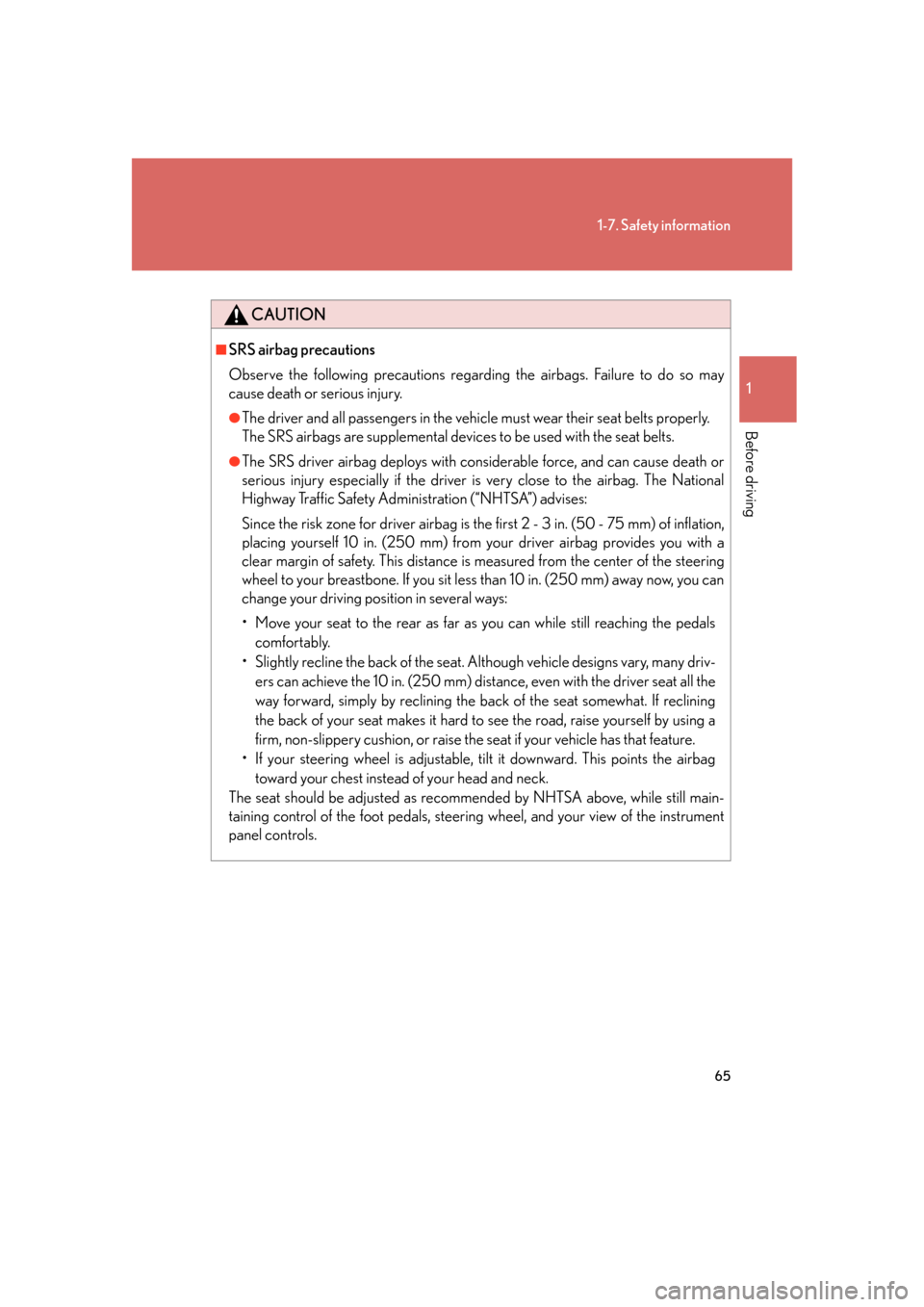
65
1-7. Safety information
1
Before driving
CAUTION
■SRS airbag precautions
Observe the following precautions regarding the airbags. Failure to do so may
cause death or serious injury.
●The driver and all passengers in the vehicle must wear their seat belts properly.
The SRS airbags are supplemental devices to be used with the seat belts.
●The SRS driver airbag deploys with considerable force, and can cause death or
serious injury especially if the driver is very close to the airbag. The National
Highway Traffic Safety Administration (“NHTSA”) advises:
Since the risk zone for driver airbag is th e first 2 - 3 in. (50 - 75 mm) of inflation,
placing yourself 10 in. (250 mm) from your driver airbag provides you with a
clear margin of safety. This distance is measured from the center of the steering
wheel to your breastbone. If you sit less than 10 in. (250 mm) away now, you can
change your driving position in several ways:
• Move your seat to the rear as far as you can while still reaching the pedals
comfortably.
• Slightly recline the back of the seat. Al though vehicle designs vary, many driv-
ers can achieve the 10 in. (250 mm) distan ce, even with the driver seat all the
way forward, simply by reclining the back of the seat somewhat. If reclining
the back of your seat makes it hard to see the road, raise yourself by using a
firm, non-slippery cushion, or raise the seat if your vehicle has that feature.
• If your steering wheel is adjustable, ti lt it downward. This points the airbag
toward your chest instead of your head and neck.
The seat should be adjusted as recommended by NHTSA above, while still main-
taining control of the foot pedals, steering wheel, and your view of the instrument
panel controls.